Maintaining an older motorcycle model is like keeping a classic car running in perfect condition—it requires a near-obsessive level of attention. You might think you can just hop on and ride, but neglecting routine checks can lead to serious issues down the road. From oil changes to electrical system diagnostics, each aspect plays a vital role in your bike's longevity and performance. So, what are the essential steps you need to take to guarantee your bike stays in top shape? The answers might surprise you.
Quick Takeaways
- Perform regular oil changes every 3,000 to 5,000 miles for optimal engine performance and longevity.
- Inspect electrical systems frequently, checking battery connections and testing all lights and signals for functionality.
- Regularly check tire pressure, tread depth, and brake components to ensure overall safety and handling.
- Conduct preventative maintenance inspections to identify potential issues early, preventing costly repairs and enhancing reliability.
Understanding Suzuki Motorcycle History
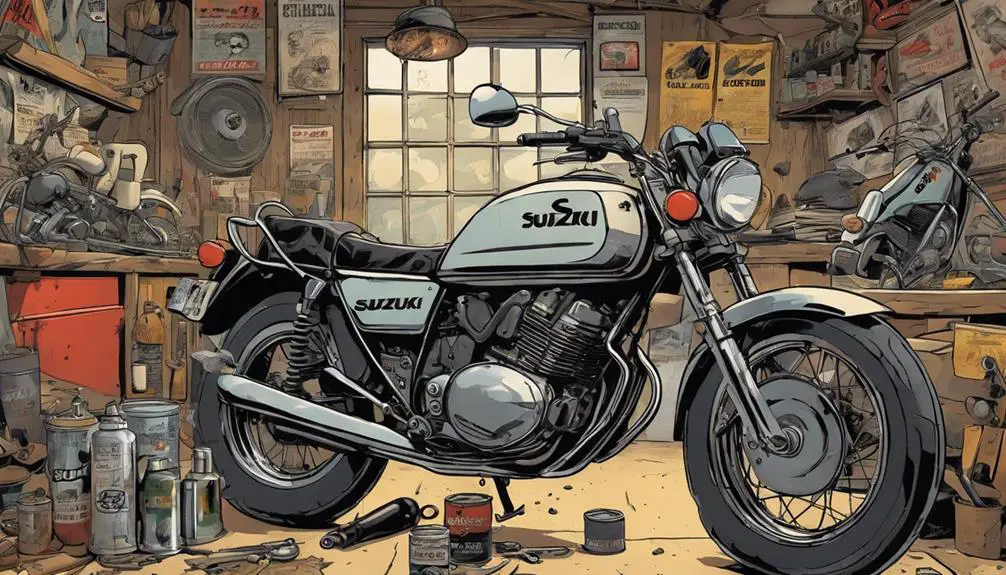
To truly appreciate older Suzuki motorcycles, you need to understand their rich history and evolution in the motorcycle industry.
Suzuki began its journey in the late 1950s, initially focusing on small, lightweight bikes. By the 1960s, they were paving the way for innovation with models like the Suzuki T20, showcasing their commitment to performance and style. These bikes weren't just machines; they were gateways to freedom, allowing riders to explore the open road.
As the years rolled on, Suzuki pushed boundaries with the introduction of two-stroke engines, which offered a unique combination of power and efficiency. This innovation allowed riders to experience a thrilling ride while enjoying the liberation that comes from hitting the highway. The iconic models of the 1970s, such as the GT750, solidified Suzuki's place in motorcycle history and became symbols of rebellion and adventure.
Understanding this evolution helps you connect with the spirit of older Suzuki motorcycles. Each ride carries the legacy of a brand that's always been about breaking free and embracing the journey. So, when you're on an older Suzuki, you're not just riding a bike; you're part of a story of passion and liberation.
Key Specifications of Older Models
Understanding the key specifications of older Suzuki motorcycle models is essential for appreciating their performance and charm. These bikes often come equipped with air-cooled engines, which not only offer simplicity but also a certain rugged appeal. You'll typically find engines ranging from 125cc to 1100cc, giving you options based on your riding style and preference.
The frame design is another vital aspect; many older models feature a classic tubular steel frame that contributes to durability and handling. This sturdiness allows you to tackle various terrains with confidence.
Pay attention to the suspension setup as well—most older Suzukis utilize conventional forks in the front, providing a straightforward riding experience.
Braking systems vary, too. While drum brakes were common in early models, you'll find some equipped with disc brakes, enhancing stopping power and safety.
Additionally, older models often sport distinctive styling, with chrome accents and retro paint schemes that evoke a sense of freedom and nostalgia.
Common Problems in Suzuki Motorcycles
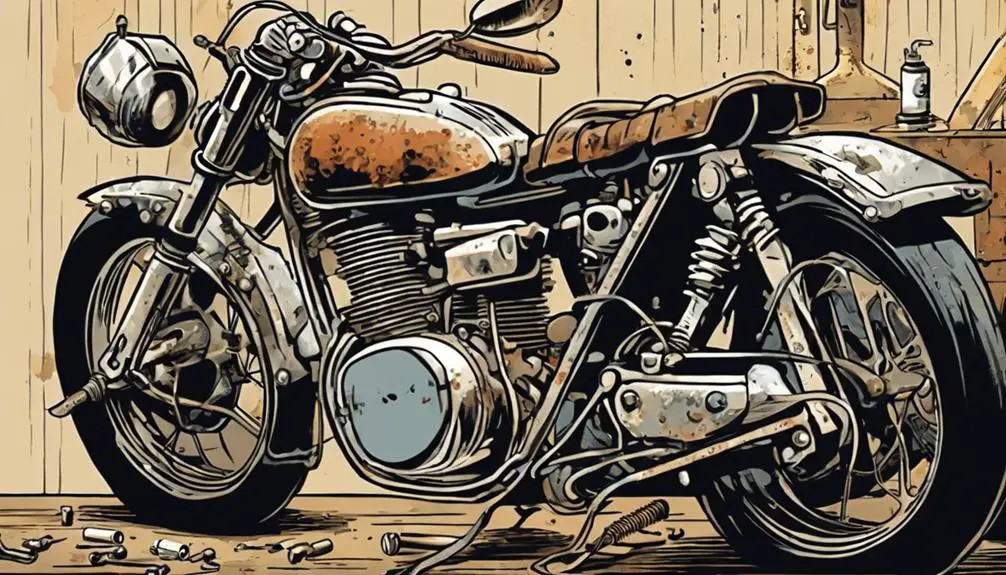
Older Suzuki motorcycles can face a range of common issues that every owner should be aware of to secure a smooth riding experience.
One of the most frequent problems is electrical system failure. You may notice flickering lights or a dead battery, which often stems from corroded connections or a failing voltage regulator. It's vital to inspect these components regularly.
Another issue relates to fuel system problems. Clogged fuel filters or dirty carburetors can lead to poor performance or stalling. Cleaning these parts can restore your bike's power and efficiency.
You might also encounter oil leaks, particularly around gaskets and seals. If you spot oil on the ground, it's a sign that something needs fixing.
Lastly, pay attention to your brakes. Older models might struggle with worn pads or corroded calipers, which can compromise safety. Regularly checking and replacing these components guarantees you remain in control on the road.
Importance of Preventative Maintenance
Preventative maintenance is key to keeping your older Suzuki motorcycle running smoothly and avoiding many of the common problems that can arise over time. By taking the initiative to care for your bike, you empower yourself to enjoy the freedom of the open road without unexpected breakdowns. Regularly checking and maintaining your motorcycle not only extends its lifespan but also guarantees you experience the thrill of riding without worry.
When you engage in preventative maintenance, you're not just preserving your bike; you're enhancing your riding experience. It allows you to discover potential issues before they escalate into costly repairs. Whether it's changing the oil, inspecting the brakes, or keeping an eye on tire pressure, these small actions can make a big difference.
Moreover, a well-maintained motorcycle offers you the confidence to ride longer distances and explore new paths. You'll find liberation in knowing your bike is reliable and ready for adventure.
Regular Inspection Techniques
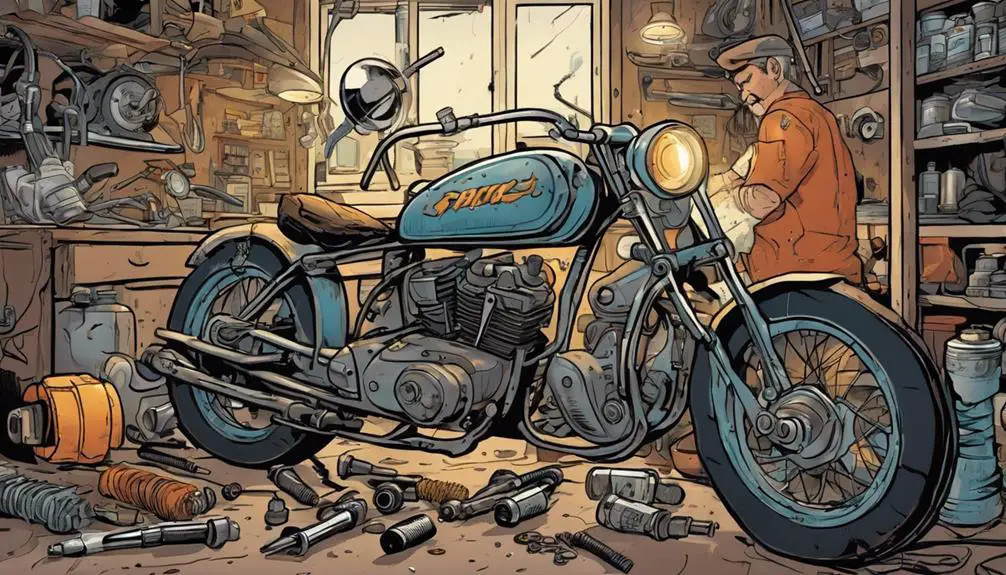
Regular inspections are vital to guaranteeing your motorcycle performs at its best, helping you catch potential issues before they turn into serious problems.
Start by checking your tires; look for uneven wear and proper inflation. A quick visual inspection can save you from a blowout on the open road.
Next, inspect your brakes. Squeeze the brake lever and listen for any unusual sounds. If you hear grinding or feel a spongy response, it's time to investigate further.
Don't forget to check your lights and signals. Turn them on and walk around your bike to verify everything's functioning correctly. Visibility is key to your freedom on the road.
Also, examine the chain for proper tension and lubrication. A well-maintained chain is essential for smooth rides and efficiency.
Engine Care and Maintenance
Taking care of your motorcycle's engine is essential for its longevity and performance.
Regular oil changes and inspecting the fuel system can make a significant difference in how smoothly your bike runs.
Regular Oil Changes
Changing the oil in your older motorcycle is vital for keeping the engine running smoothly and efficiently. Regular oil changes help to remove dirt, debris, and other contaminants that can accumulate over time. This isn't just routine maintenance; it's a way to liberate your engine from unnecessary wear and tear.
Aim to change the oil every 3,000 to 5,000 miles, depending on your riding habits and the type of oil you use. Using high-quality oil that meets your motorcycle's specifications can make a world of difference, allowing your engine to breathe and perform at its best.
Don't forget to replace the oil filter during each change. A clean filter guarantees that the oil circulating through your engine remains free from impurities.
When you perform an oil change, take a moment to inspect the oil's color and consistency. If it looks dark and gritty, it's time for a change.
Inspecting Fuel System
Along with oil changes, inspecting the fuel system is vital for keeping your older motorcycle running at peak performance. Start by checking the fuel lines for any cracks or leaks; even small issues can lead to bigger problems down the road. Tighten any loose connections and replace damaged hoses to guarantee a smooth flow of fuel.
Next, take a close look at the fuel filter. If it's clogged, it can restrict fuel flow and impact your bike's performance. A clean filter is essential for that liberating ride you crave. Depending on your model, you might need to replace the filter annually or every few thousand miles.
Don't forget to inspect the carburetor or fuel injectors. Clean them thoroughly to prevent gunk buildup that can hinder performance. If you notice any inconsistencies in how your bike runs—like stalling or poor acceleration—it may be time to dive deeper into the fuel system.
Lastly, confirm you're using high-quality fuel. Cheap gas can contain contaminants that damage your system. By staying on top of these checks, you'll enjoy every moment on your motorcycle with confidence and freedom.
Electrical System Checks
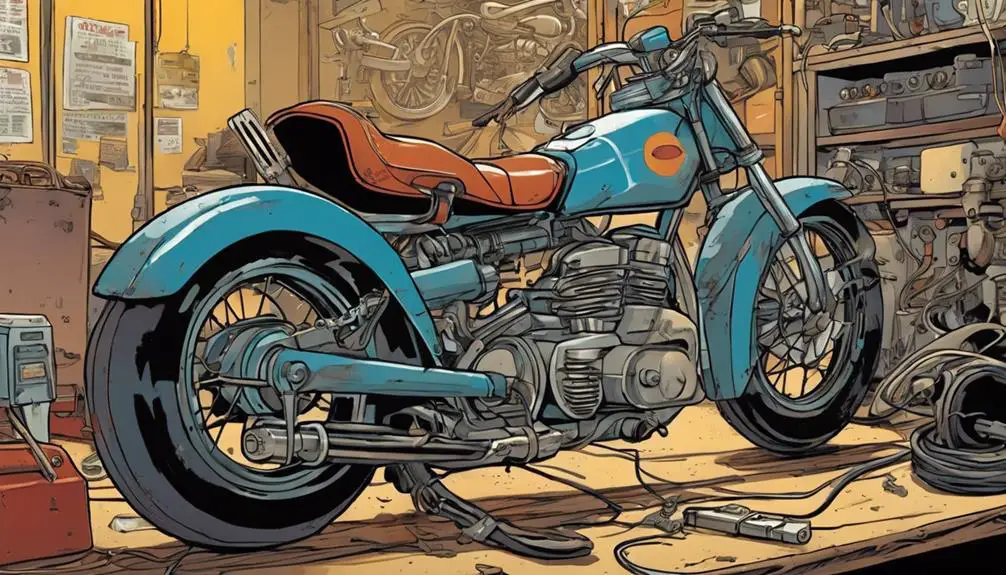
Before hitting the road, you should regularly inspect your motorcycle's electrical system to confirm all components are functioning properly.
Start by checking the battery. Make sure it's securely mounted, terminals are clean, and connections are tight. A weak battery can leave you stranded, so consider testing its voltage if you're unsure about its health.
Next, examine your wiring harness for any signs of wear, fraying, or corrosion. Damaged wires can cause shorts or other electrical issues, compromising your freedom on the open road. Don't forget to check the fuses; replace any that are blown to confirm your lights and indicators work.
Your lights are essential for visibility, so test both front and rear lights, including turn signals and brake lights. If a bulb's out, replace it promptly.
Finally, pay attention to the charging system. When the engine's running, the voltage should typically be around 13.5 to 14.5 volts. If it's lower, you might need to inspect the alternator.
Taking these simple steps will help confirm your motorcycle's electrical system is in top shape, giving you the confidence to ride freely wherever the road takes you.
Tire and Brake Maintenance
Tires and brakes are crucial for your safety, so regular inspections are necessary to guarantee they're in ideal condition.
Start by checking your tire pressure; under-inflated tires can lead to poor handling and increased wear. Make it a habit to inspect your tread depth too—if it's worn down to 1/16 of an inch, it's time for a replacement.
Next, examine your brake pads and discs. Squeaking or grinding sounds are red flags that signify it's time to replace them. You should also check the brake fluid level; low fluid can lead to brake failure. If you notice any leaks or discoloration, address it immediately.
Don't forget to inspect the brake lines for cracks or wear. Your brakes are your lifeline on the road, and keeping them in top shape is key to enjoying that liberating ride.
Storing Your Motorcycle Properly
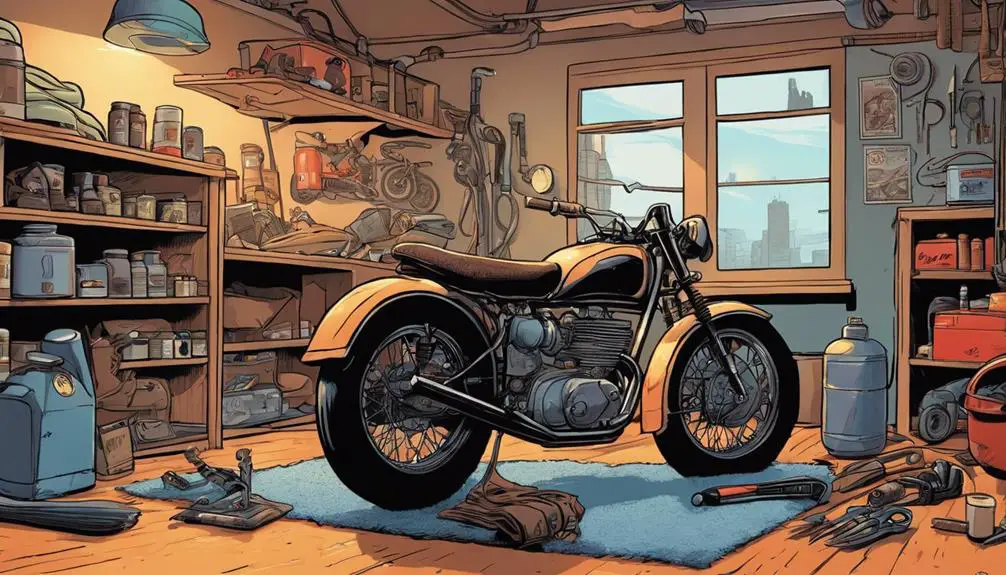
When it comes to storing your motorcycle, proper preparation is key.
Clean it thoroughly before putting it away, use the right covers to protect it from dust and moisture, and keep an eye on your battery's health.
Taking these steps will guarantee your bike stays in great shape until you're ready to ride again.
Clean Before Storage
Cleaning your motorcycle thoroughly before storage helps prevent rust and corrosion, ensuring it stays in top condition for your next ride. You want your bike ready to roar the moment you hit the road again. Here's how you can make it shine and protect it from the elements:
- Wash and Dry: Start with a gentle wash using a motorcycle-specific cleaner. Rinse thoroughly and dry it well to avoid water spots.
- Chain Maintenance: Clean and lubricate the chain. This simple step goes a long way in preventing rust and ensuring smooth rides.
- Inspect and Clean: Check for any signs of wear and tear. Clean the air filter and inspect brake pads. A little attention now saves headaches later.
Taking these steps doesn't just clean your bike; it shows you care about the freedom it brings you.
With a well-maintained motorcycle, you can embrace the open road whenever the spirit moves you.
Use Proper Covers
After you've cleaned your motorcycle, using proper covers is essential for protecting it from dust, moisture, and UV damage during storage. A good cover acts as a shield against the elements, ensuring your ride remains in peak condition. Opt for breathable materials that prevent moisture buildup, which can lead to rust and corrosion.
You want a cover that fits snugly without being too tight, allowing air circulation while keeping debris out. Look for options with UV protection, especially if your bike is parked in sunlight. This will help preserve the paint and prevent fading, keeping your motorcycle looking fresh and vibrant.
Avoid using regular tarps or plastic sheets; they can trap moisture and create a breeding ground for mildew. Instead, invest in a high-quality motorcycle cover designed for your specific model. The right cover not only protects but also shows you care about your bike's longevity.
Maintain Battery Health
Maintaining your motorcycle's battery health is essential, especially during long storage periods. A well-maintained battery guarantees that your ride starts smoothly when you're ready to hit the open road again. Here are some tips to keep your battery in top shape:
- Disconnect the battery: If you're storing your bike for a while, disconnect the negative terminal to prevent any drain.
- Use a battery maintainer: Invest in a smart charger or maintainer. These devices keep your battery charged without overloading it.
- Store in a cool, dry place: Extreme temperatures can damage your battery. Find a stable environment that's not too hot or cold.
Common Questions
What Tools Are Essential for Maintaining Older Motorcycle Models?
To maintain older motorcycle models, you'll need a few essential tools.
Start with a good set of wrenches and sockets for adjustments and repairs. A reliable torque wrench guarantees you don't over-tighten bolts.
Don't forget a quality multimeter for electrical issues and a basic tool kit for minor fixes.
A motorcycle stand helps you work comfortably, and a tire pressure gauge keeps your ride safe.
With these tools, you'll feel empowered to keep your bike running smoothly.
How Do I Find Parts for Vintage Suzuki Motorcycles?
Finding parts for vintage Suzuki motorcycles can feel like a treasure hunt.
Start by checking online forums and communities where fellow enthusiasts share resources. Websites specializing in vintage motorcycle parts often stock what you need.
Don't forget to visit local bike shops or salvage yards—they can have hidden gems.
You might also consider joining social media groups dedicated to Suzuki lovers; they often post leads on hard-to-find components.
Happy hunting!
Can I Upgrade My Older Suzuki Without Compromising Its Value?
You can definitely have your cake and eat it too when it comes to upgrading your older Suzuki.
Focus on enhancements that improve performance without altering its classic charm.
Consider subtle mods like a new exhaust or upgraded brakes—these can boost your ride without considerably affecting its value.
Just keep the original parts safe; they'll always be valuable if you decide to revert.
Embrace the freedom to personalize while respecting its history!
What Are Cost-Effective Ways to Restore an Older Motorcycle?
Restoring an older motorcycle doesn't have to break the bank.
Start by sourcing affordable parts online or at local salvage yards.
You can also tackle minor repairs yourself with some basic tools and online tutorials.
Cleaning and repainting can dramatically improve appearance without high costs.
Look for community forums where enthusiasts share budget-friendly tips.
How Do I Join a Community for Vintage Motorcycle Enthusiasts?
To join a community for vintage motorcycle enthusiasts, start by searching for local clubs or online forums dedicated to classic bikes.
Attend motorcycle shows and events where you can meet fellow riders.
Social media's a great tool—follow relevant groups and participate in discussions.
Don't hesitate to introduce yourself; most enthusiasts are enthusiastic to share their passion.
You'll find camaraderie and valuable insights, making your vintage motorcycle journey even more enjoyable.
Wrapping Up
Maintaining an older Suzuki motorcycle isn't just about fixing problems; it's about creating a bond with your ride that lasts.
When you prioritize regular inspections and preventative care, you'll find that your bike rewards you with reliability and smooth rides.
Coincidentally, each oil change or brake check brings you closer to understanding your motorcycle's quirks and character.
So, invest the time in maintenance, and you'll enjoy not only a longer lifespan for your bike but also countless adventures together.